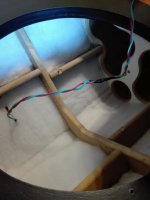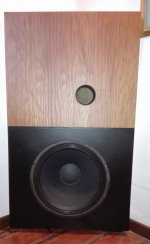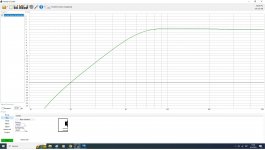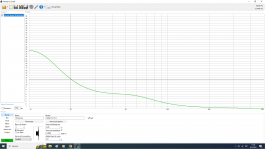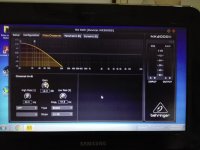" That dates back to the days when damping was thought of as a method of controlling low frequency standing waves in very large cabs. The theory was that if you rendered one of the parallel surfaces in the cab non-reflective then you didn't need to bother with the other parallel surface. Said theory was seriously flawed, as the thickness of damping required to suppress standing wave development was too much to realize when treating only one panel, although I guess it might have been realized with 6 inches of Type 700. 😱" I wanted to ask: What is the rationale behind not lining some cabs walls? "
Anyone giving that advice today is some 40 years removed from state of the art engineering. "
https://www.avsforum.com/threads/i-...-the-walls-of-my-sub-with-foam.2685017/page-2
What do you think of this answer ? 🤔
Do not use fiberglass!I plan to cover ONLY the bottom side walls with fiberglass
Use rockwool or some kind of felt, melamine foam or whatever else like old fleece sweaters or something, why not re-use the polyfill?
BTW:
I plan to experiment with this wood based insulation I am currently using on my house, it comes in 50mm thickness too.
In the same website, there are measurements on Walmart pillows providing positive results in the Quad $29 JBL 12 Devastator." That dates back to the days when damping was thought of as a method of controlling low frequency standing waves in very large cabs. The theory was that if you rendered one of the parallel surfaces in the cab non-reflective then you didn't need to bother with the other parallel surface. Said theory was seriously flawed, as the thickness of damping required to suppress standing wave development was too much to realize when treating only one panel, although I guess it might have been realized with 6 inches of Type 700. 😱
Anyone giving that advice today is some 40 years removed from state of the art engineering. "
https://www.avsforum.com/threads/i-...-the-walls-of-my-sub-with-foam.2685017/page-2
What do you think of this answer ? 🤔
In 2017 I built two LLT subs with the B&C 21SW152/8. The enclosures are 540L each and the tuning is 11Hz exactly to avoid a high GD at 20Hz and up. As the boxes are huge and the movies that deliver real infrasonics actually are quite rare, I'll probably build new/smaller 250L enclosures with a higher tuning (17Hz) and even then the GD @ 20Hz is only 22ms compared to 11ms for a sealed box. At 30Hz the GD difference is negligible. The 8dB gain @15hz is more than welcome for movies.
I also have a large sealed sub with 4x 15" Visaton TIW400 (vintage) in separate volumes that are corner loaded. These 8 Ohm woofers are fed by a Crown XLS2502 in Y-modus. Each channel powers 2 woofers in parallel. Now my thought was to use different LPF for each channel; 200Hz for channel A and 30Hz for channel B. A simulation in WinISD shows a GD below 10ms for the 200Hz LPF channel and surprise the channel with a 30Hz LPF shows a GD of >20ms. However to reach the same SPL on both channels the 200Hz LPF channel only needs 1W while the 30Hz LPF channel needs 20W.
I have a pair of ported bookshelf speakers here that came with a thin layer of some cotton like insulation material on the inside walls of the cabinets."
Anyone giving that advice today is some 40 years removed from state of the art engineering. "
What do you think of this answer ? 🤔
I figured I could improve the response by changing the fill to something else. Whatever I did resulted in less extension and did nothing to reduce peaking in the mid-bass, much to my amazement.
So the scant layer of whatever it is went back in to stay.
Thanks for the advice, I wrote that because I was actually thinking of glass wool, not fiber, (I always get confused) which is not so brittle and volatile, with the known risk of being inhaled into the lungs. The issue that it is carcinogenic, I leave it to discuss in another thread, JBL recommended it and used it regularly in its commercial products, I even used it in my vintage DIY coaxials of that brand, I have been listening to them for 40 years and here I am. Although I try not to listen to them without the protective cloth frame since they are BR, ha..... 😀Do not use fiberglass!
Actually, I had the idea of using a roll of discarded glass wool that I kept from a reform of the roof of my house, - it is used as acoustic and thermal insulation -, but I examined it and it also falls apart quite easily when handling it, and the strands can fly into the cabinet and enter the breath of the VC of the speaker. So it was discarded and it went to the municipal dump.
Answering my own question from my previous post, in the subwoofer frequency range, I don't see much using these dampers. Another hotly debated topic, I know, attached two interesting thread. But finally I placed it only in the lower compartment, on the sides of the speaker and the base. ( I have no " back " on this prism , which helps to lower the resonances of the box )
https://techtalk.parts-express.com/forum/tech-talk-forum/48848-polyfil-in-speakers/page4
https://data-bass.com/#/articles/5cace1c48c663e0004cd9ce2?_k=c2zq1s
Last edited:
Ok, one of the subwoofers is done.
I have been comparing performance with a 30hz tone and music with low note content, sealed against bass reflex.
It is what I was looking for! Now there are more harmonics and before the reverberation time was too short for my taste. So I am very happy ! 👍 😊 , and the modification of the second cabinet awaits me. It would be easier.
A comment about my experience:
When I chose to use this driver for sealed, I should not have gotten so excited about the group delay, and paid more attention to the following:
1) Eminence never recommended this speaker for sealing with their EBP=84 , that should have alerted me.
2) In this chart that made me make a bad decision, 84 is much closer to the BR zone than "either" .......😒
https://www.diyaudioandvideo.com/Calculator/SealedVsPortedSpeakerBox/
I have been comparing performance with a 30hz tone and music with low note content, sealed against bass reflex.
It is what I was looking for! Now there are more harmonics and before the reverberation time was too short for my taste. So I am very happy ! 👍 😊 , and the modification of the second cabinet awaits me. It would be easier.
A comment about my experience:
When I chose to use this driver for sealed, I should not have gotten so excited about the group delay, and paid more attention to the following:
1) Eminence never recommended this speaker for sealing with their EBP=84 , that should have alerted me.
2) In this chart that made me make a bad decision, 84 is much closer to the BR zone than "either" .......😒
https://www.diyaudioandvideo.com/Calculator/SealedVsPortedSpeakerBox/
Attachments
I am glad your experiment is a success. It raises a very important point of personal taste in audio - the subjective sound of the sub is improved to your ears even though through your description, the fidelity is actually worse.Now there are more harmonics and before the reverberation time was too short for my taste.
I can't help but notice that there's a large blank open area that could hold an entire second woofer...
You are keeping the same drivers as before, right? Then you can easily switch back to what you previously had by plugging the port. If the mood hits you.
Ok, one of the subwoofers is done.
I have been comparing performance with a 30hz tone and music with low note content, sealed against bass reflex.
It is what I was looking for! Now there are more harmonics and before the reverberation time was too short for my taste. So I am very happy ! 👍 😊 , and the modification of the second cabinet awaits me. It would be easier.
A comment about my experience:
When I chose to use this driver for sealed, I should not have gotten so excited about the group delay, and paid more attention to the following:
1) Eminence never recommended this speaker for sealing with their EBP=84 , that should have alerted me.
2) In this chart that made me make a bad decision, 84 is much closer to the BR zone than "either" .......😒
https://www.diyaudioandvideo.com/Calculator/SealedVsPortedSpeakerBox/
You are keeping the same drivers as before, right? Then you can easily switch back to what you previously had by plugging the port. If the mood hits you.
This is one of my favorite CDs, Charlie's double bass has passed the test with flying colours.
Enjoy it, you won't regret it. PS: It's addictive, you've been warned.
Enjoy it, you won't regret it. PS: It's addictive, you've been warned.
Now there are more harmonics and before the reverberation time was too short for my taste.
That was my first reaction as well, but it could be the perceived effect of "more harmonics" translate to: "more detail in the lower bass region".the subjective sound of the sub is improved to your ears even though through your description, the fidelity is actually worse.
And using a driver more suitable for vented designs in a sealed volume without any EQ would lack a fair bit of impact down low, you would get a good initial reaction from a kick but the last bit in lower frequencies sounds kind of over-damped.
@academia50 We are curious as to what you are experiencing, please activate analytical mode and try to discern if the impact or group delay is any worse, are you experiencing a more detailed kind of bass or a more muddy kind of bass?
Through my experiments I found that some inadequately designed vented designs exhibit increased distortion at certain frequencies when pushed, I also found that this can actually be used to an advantage because most people like a bit of distortion for some reason, and you can make the bass seem to be slightly "more output" than it really is through the increased harmonic distortion.
This is easier to do with slot ports where you have more surface area to increase the drag coefficient, which in turn can also slightly help reduce driver movement just a little bit more above and below the tuning frequency. So it can in some instances work like a almost like a mechanical limiter to a certain degree.
If you do it wrong it is difficult to discern the notes and details in the bass and everything just falls apart.
If you do it intentionally you can still hear the details fine at lower levels but when you push it hard you get a slight increase in harmonics and that makes the bass seem a bit fuller.
This is easier to do with slot ports where you have more surface area to increase the drag coefficient, which in turn can also slightly help reduce driver movement just a little bit more above and below the tuning frequency. So it can in some instances work like a almost like a mechanical limiter to a certain degree.
If you do it wrong it is difficult to discern the notes and details in the bass and everything just falls apart.
If you do it intentionally you can still hear the details fine at lower levels but when you push it hard you get a slight increase in harmonics and that makes the bass seem a bit fuller.
That description is correct, that's how I perceive it. 👍That was my first reaction as well, but it could be the perceived effect of "more harmonics" translate to: "more detail in the lower bass region".
And using a driver more suitable for vented designs in a sealed volume without any EQ would lack a fair bit of impact down low, you would get a good initial reaction from a kick but the last bit in lower frequencies sounds kind of over-damped.
@academia50 We are curious as to what you are experiencing, please activate analytical mode and try to discern if the impact or group delay is any worse, are you experiencing a more detailed kind of bass or a more muddy kind of bass?
I do not perceive any distortion that can be attributed to a GD, I already mentioned 20 Hz before, in my construction it is 12.449 Ms.
These subwoofers were built to listen to the lower octaves of the musical spectrum.
The loss of -20 Db at 20 Hz with DSP is compensated, + 12 Db is the maximum that the NX Edit software allows me, attached graphics. In addition, we owe other extra Db from the second sub. With only one (the BR) the room is flooded with clean and well-defined bass.
I never intended for there to be "punch", but it does, and lots of it, that's what this speaker was made for, I've tested it.
But, that doesn't interest me, and if one day I want to make a danceable disco in my house, I'll just modify the FR with DSP, ha, I don't see it as possible, I'm playing the extra time of the game.
Attachments
- Home
- Loudspeakers
- Subwoofers
- Sealed subwoofer to bass reflex, what do I gain and what do I lose ?


